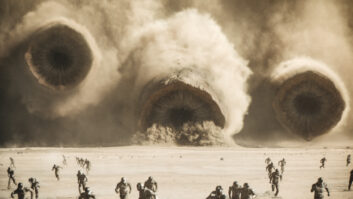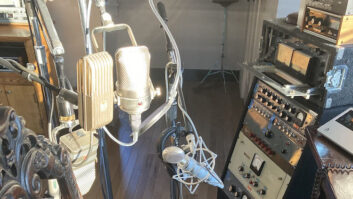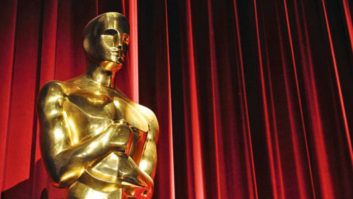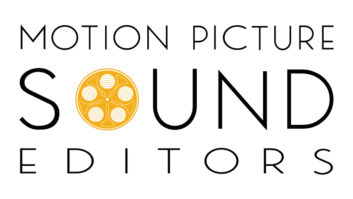Home studios are the norm these days. But the evolution of music composer Denis Hannigan’s home studio was a little different from most. When the busy Hannigan, who took home 2001’s ASCAP Award for “Most Performed Underscore,” found his Topanga Canyon studio taking over his home, he let it. Instead of moving the studio out of his house, he moved his family out — to a new home nearby. He then set about rebuilding and upgrading his workspace.
Hannigan has provided music for over 300 television episodes, with the bulk of his work in scoring for animation. His music is heard on many of today’s most popular TV cartoon series, from Disney’s top-rated Recess to Nickelodeon’s now-classic Rugrats and the hilarious-even-to-adults CatDog. Hannigan also provided the score for television’s Beakman’s World and Adventures in Wonderland, and for feature films such as the animated Recess: School’s Out, CatDog and the Great Parent Mystery, and the live actioners The Girl Next Door, Foxhunt and The New Shaggy Dog.
Hey, we said he was busy. Anyone who has attempted to write music for a weekly series knows how punishing the schedules can be. Hannigan has been doing it for over 10 years, frequently juggling multiple projects. Therefore, in designing his new studio, all of the experience he’s gained came into play. So did the need to create a room that would work equally well for writing music and for creating finished mixes of that music.
“I have clients from Disney and Nickelodeon who come here, and I wanted them to be really comfortable,” he explains. “But it’s also a writer’s studio. I have to be able to work fast, because our time frames are so tight. And a dilemma that I and a lot of my friends who are building studios run into is you have to make decisions about whether writing or mixing takes priority.”
The issue? Proper acoustics vs. an inspirational environment. For Hannigan, there were two main questions. What goes in the center, in front of the screen and between the monitors: the mixing console or the composing keyboard? And, could he really keep his inspiring vista of Topanga Canyon, viewed through a wall of sliding glass doors that encompass one whole side of the control room? Resolving this conundrum took the help of mixing engineer Leslie Chew, engineer/studio designer Rick Ruggieri and acoustic specialist Bob Hodas. The result: A bright, open space for composing and recording that, with the addition of window treatments, also provides for high-quality mixes. And a pleasingly ergonomic recording and mixing arrangement with a centered main keyboard and a corner workstation.
“I make my money by writing,” Hannigan explains. “So what I’m doing 90 percent of the time is composing. When I am, I want to see my view; I want to be able to walk out on the deck. When it’s time to mix, I put the blinds down and focus on that.”
Hannigan, who is musically proficient on woodwinds and saxophone as well as keyboards, prefers to use live musicians on his projects whenever possible. A graduate of the UCLA Film Scoring program, he got his start in the animation business working with composer and Devo member Mark Mothersbaugh.
“I was working for Mark, programming and helping him with the computers in the studio when he got a call to do a series,” Hannigan recalls. “He’d been writing very cool music, doing commercials and some shows, but he hadn’t really scored a series. He knew my music and asked me to help him. It was a kids’ show called Adventures in Wonderland. Then, while I was doing that, Rugrats happened. Mark wrote the theme, and then he brought me in to do the score. It took off from there.
“We worked together for almost five years,” Hannigan continues. “We were working by e-mail even back then, in the early ’90s. I was here in Topanga and he was in the Hollywood Hills. I set up his studio so that my files would open up in his system and be emulated. All my instruments would map over to his and his engineer would just mix them; we did all virtual tracks.”
Hannigan continues to work in virtual mode. “I want everything up all the time for writing,” he says. “That’s another physical dilemma with project studios — being able to have everything wired in so it comes up all the time. Plug-ins, of course, are nice for that — everything is right there. But I don’t always like to use them. Sometimes what technology like that does is just make everything sound the same. We stay mostly hardware DSP-based, which I think adds more character.”
“We use plug-ins for specific applications,” adds Chew, Hannigan’s longtime engineer. “But we use the hardware DSPs for blanket reverbs and effects. When Denis starts up a new piece, he works from a template for that particular show. Then, as we’re mixing, we’ll add plug-ins for more special effects.”
Hannigan uses a Kurzweil PC88 as his keyboard controller. Favorite sound modules include GigaStudio, Virus B, Waldorf Q and a Novation Super Nova II. He uses Logic Audio Platinum software, and the core of his recording setup is a Mackie D8B, a 72-channel digital mixer that feeds two Pro Tools systems: Mix Plus 24 and Pro Tools III. The Mix Plus system is used in conjunction with Logic Audio to provide the digital audio component for the MIDI sequencing system, allowing both MIDI and digital audio tracks to be locked to digital video in the same program. Live players are also recorded to the Mix Plus. The Pro Tools III, with a Digidesign USD, is used as a mixdown machine. The final mix, derived from the Mackie D8B, is routed to the Pro Tools III, where it is broken down to anywhere from eight to 16 stems, which are then delivered to the dubbing stage on CD-R in a Pro Tools file format.
While a specific template of sounds is the starting point for the score of each week’s show, with the use of three Mackie 3204 submixers, 152 inputs can be available at any one time. When it comes to mixing, though, Hannigan and Chew find that, more and more, they tend to mix inside the box using a mouse and a keyboard.
“I do most of the automation either in Pro Tools or in the sequencer, as opposed to on the console,” notes Chew. “It’s faster that way, since I’m on the computer driving the sequencer anyway. Also, if Denis needs to do a recall, he doesn’t necessarily have to deal with console automation recall. He just recalls one snapshot on the mixer, and everything else is in the computer.”
Hannigan’s control room is equipped with an 82-inch Stewart Greyhawk screen to accompany the wide-aspect Sony VPL-10HT LCD front projector. The complex, which also includes a live recording space, Studio B for writing, editing and making dubs, and a kitchen and lounge area, is wired throughout with SVHS, making video available in every room of the building. It is also Ethernet-networked for backup and file transfer.
Topanga Canyon remains one of the more remote areas of Greater L.A., so sound isolation was not a big issue. Air conditioning, however, was another matter. “The air conditioning was really a challenge in a little place like this,” comments Hannigan. “I wanted a very quiet studio environment. We had to use long runs of Soundflex ducting and some rather complex ways of handling air to keep the noise down, without slowing the airflow too much. I could only fit one 4-ton unit at the site, so we put the main thermostat in Studio A and used thermostat-driven variable dampers in the other rooms. You can barely fit under the house now with all the ducting and conduit, but the studio is quiet!”
As any parent knows, today’s kids are extremely sophisticated, and the shows that become hits reflect that sophistication. So do Hannigan’s scores.
“It’s not hip now to overstate,” he explains. “I learned a long time ago that you can’t dumb things down too much because kids know, and they don’t like that. There are some shows that you can put in the good classic stuff, but most are in the style of The Simpsons; a little sarcastic, just a little more smart.”
In composing for the quirky CatDog, with its half-feline, half-canine protagonist, Hannigan records dobro, acoustic and electric guitar, ukulele, harmonica and bass harmonica, along with MIDI sounds every week. The music, written in his synthesizer, is e-mailed to his copyist, who imports the files into Finale, then prepares the music and faxes the written music back to the studio.
“We save time, the parts look pretty good and the players never complain,” comments Hannigan. “Leslie and I then spend a day recording the musicians into my sequencer and afterward make any revisions. The next day is spent mixing, with delivery to the stage by messenger in the p.m.
“Working with an engineer who knows all the software is essential to this process,” he continues. “I only have five to six days from start to finish for each episode; that’s approximately 20 minutes of music. Scoring 65 half-hour episodes for CatDog, another equal volume of Recess and two features, all of it done over a period of two-and-a-half years… it takes an enormous amount of focus.”
Hannigan finds that his Topanga retreat studio provides him with the kind of environment he needs to concentrate on being creative with a minimum of distraction. “You don’t have to move to where your clients are anymore; your clients can be anywhere,” he says. “Twenty years ago, the business was more focused. There were only a handful of studios, and all the businesses grew up in the same area. Now, with project studios and package deals, no one knows where anyone is working. And now, the quality of equipment that you can get for a home studio makes it possible to do this.
“The economy drives our business,” he concludes. “I’m working the way I am because of the economy. But working this way is more than anybody bargains for. I have to know software, formats, machines, synths, wiring, etc. I have to be responsible for all sorts of business-type things, and I have to have other people working for me. I am not just a composer anymore; I am now a music services company.”






